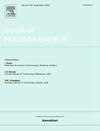Decoupling control for pressurizer pressure and water level in nuclear power plants based on a Proportional–Integral–Derivative Neural Network
IF 2.3
3区 工程技术
Q1 NUCLEAR SCIENCE & TECHNOLOGY
引用次数: 0
Abstract
The pressurizer plays a crucial role in nuclear power plants, ensuring reactor safety by maintaining stable pressure and water levels. It is characterized by nonlinearity, time-varying dynamics, and strong coupling. Conventional single-loop PID control systems often fail to decouple pressure and water level effectively, resulting in suboptimal performance, particularly under large load variations. To address these challenges, this study presents a novel decoupling control system based on a Proportional–Integral–Derivative Neural Network (PIDNN). The PIDNN is employed to mitigate the intense coupling effects between control loops. Furthermore, the Dung Beetle Optimizer (DBO) algorithm is integrated to optimize the initial weights of the PIDNN. A three-region pressurizer model is developed in MATLAB/Simulink for validation. The simulation results demonstrate that the proposed method significantly enhances the control performance and dynamic response speed of the pressurizer’s pressure and water level under typical load rejection transients in nuclear power plants, compared to traditional PID control. This method also exhibits advantages in robustness, adaptability, and engineering applicability, offering an innovative and effective solution for the decoupling control of pressurizers in nuclear power plants.
基于比例-积分-导数神经网络的核电站稳压器压力与水位解耦控制
稳压器在核电站中起着至关重要的作用,通过保持稳定的压力和水位来确保反应堆的安全。它具有非线性、时变动力学和强耦合的特点。传统的单回路PID控制系统往往不能有效地解耦压力和水位,导致性能不理想,特别是在大负荷变化下。为了解决这些挑战,本研究提出了一种基于比例-积分-导数神经网络(PIDNN)的新型解耦控制系统。采用PIDNN来减轻控制回路之间的强烈耦合效应。在此基础上,结合屎壳虫优化器(DBO)算法对PIDNN的初始权值进行优化。在MATLAB/Simulink中建立了三区域稳压器模型进行验证。仿真结果表明,与传统PID控制相比,该方法显著提高了核电站典型甩负荷瞬态下稳压器压力和水位的控制性能和动态响应速度。该方法还具有鲁棒性、适应性和工程适用性等优点,为核电站稳压器解耦控制提供了一种新颖有效的解决方案。
本文章由计算机程序翻译,如有差异,请以英文原文为准。
求助全文
约1分钟内获得全文
求助全文
来源期刊

Annals of Nuclear Energy
工程技术-核科学技术
CiteScore
4.30
自引率
21.10%
发文量
632
审稿时长
7.3 months
期刊介绍:
Annals of Nuclear Energy provides an international medium for the communication of original research, ideas and developments in all areas of the field of nuclear energy science and technology. Its scope embraces nuclear fuel reserves, fuel cycles and cost, materials, processing, system and component technology (fission only), design and optimization, direct conversion of nuclear energy sources, environmental control, reactor physics, heat transfer and fluid dynamics, structural analysis, fuel management, future developments, nuclear fuel and safety, nuclear aerosol, neutron physics, computer technology (both software and hardware), risk assessment, radioactive waste disposal and reactor thermal hydraulics. Papers submitted to Annals need to demonstrate a clear link to nuclear power generation/nuclear engineering. Papers which deal with pure nuclear physics, pure health physics, imaging, or attenuation and shielding properties of concretes and various geological materials are not within the scope of the journal. Also, papers that deal with policy or economics are not within the scope of the journal.
 求助内容:
求助内容: 应助结果提醒方式:
应助结果提醒方式:


